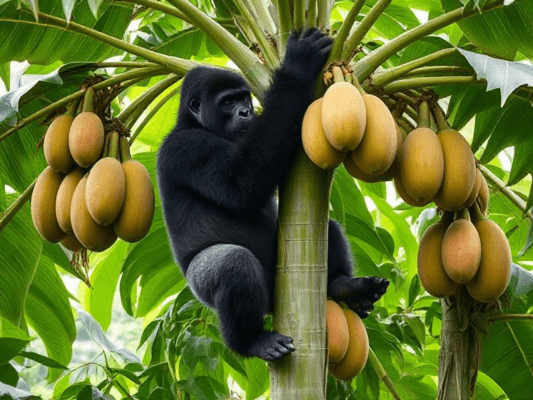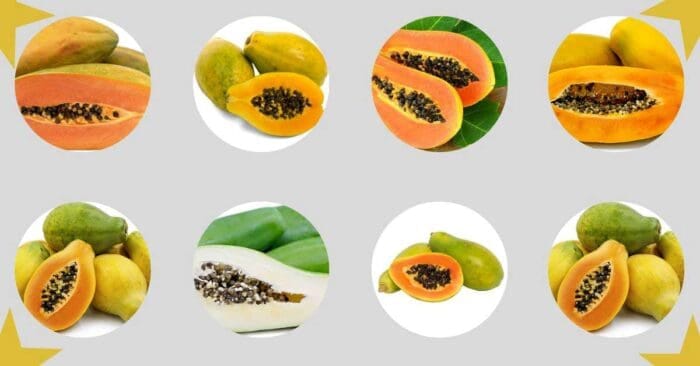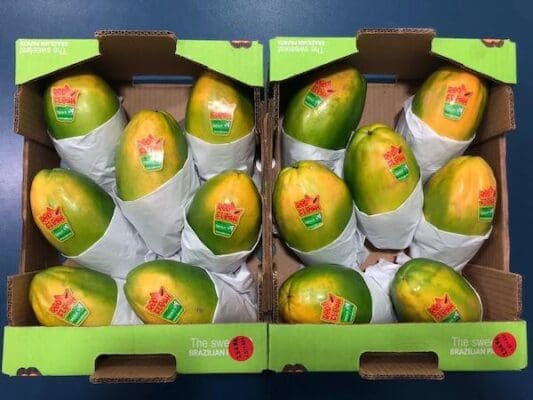Nature’s Digestive Powerhouse
Papayas are the golden giants of the tropics, offering a sweet, musky flavor with buttery-soft flesh. Unlike other fruits, they contain papain—a natural enzyme that aids digestion and even tenderizes meat! These vitamin-packed wonders grow in warm climates worldwide, transitioning from green to sunshine-yellow as they ripen.
Fun Fact: Christopher Columbus called papayas “the fruit of the angels” after tasting them in the Caribbean! The Aztecs and Mayans also revered them as sacred fertility symbols.

Papaya Varieties 🌴
1. Mexican Red (Maradol) 🔴
- Size: 3-5 lbs (most common globally)
- Appearance: Oval with green-to-yellow skin, pink-orange flesh
- Flavor: Rich and sweet with floral notes
2. Brazilian Golden 🟡🟡🟡
- Size: 2-4 lbs (premium variety)
- Appearance: Pear-shaped with golden skin
- Flavor: Intense sweetness, less musky
3. Hawaiian 🟠
- Size: 1-2 lbs (personal-sized)
- Appearance: Round, yellow-orange skin
- Flavor: Very sweet, smooth texture
My personal favorite is the Brazilian Golden because it’s more sweet.
There are many other varieties but I think the above 3 are representative. The key way to differentiate the variety is by the shape, colors, and taste. Many supermarkets will only carry 1-2 types and these types will depend on the region you live in. The Maradol and the Hawaiian are the most common in North America. Meanwhile in Asia they have their own types but the information in this guide will still be applicable.

How to Pick the Perfect Papaya
Color Clues 🎨
✅ Ripe: 75% golden yellow skin
✅ Eating Soon: 50% yellow with orange blush
🚫 Avoid: All green (won’t ripen properly)
Touch Test ✋
✅ Ready Now: Yields slightly to gentle pressure
✅ Needs Ripening: Firm but showing color
🚫 Overripe: Very soft with brown spots
Other Signs
✅ Fragrant at the stem end
✅ Heavy for its size
🚫 Bruises or oozing sap

Prepping & Storing Papaya Like a Pro
Ripening Truth:
⚠️ Once cut, ripening STOPS – the flesh will soften but won’t develop more sweetness
Storage Methods:
- Whole Papaya:
- Ripening: Leave on counter (speed up by placing near bananas)
- Ripe: Fridge for 3-5 days
- Cut Papaya:
- Peel with vegetable peeler or knife
- Halve lengthwise, scoop out seeds
- Cube flesh and store in airtight container
- Fridge for 2-3 days
If you can finish a papaya in one go, you don’t have to peel. You can cut in half, scoop out the seeds, and then scoop out the meat to eat. If your pack is behaving, they can give half for them to eat.
Papaya Power: Sweet & Savory Uses
Sweet Treats 🍧
- Breakfast Boost: Cubed over yogurt with granola
- Dessert Star: Blended into sorbet or fruit salsa
- Smoothie Base: Mixed with pineapple and coconut milk
Savory Creations 🥗
- Green Papaya Salad: Shredded with fish sauce and peanuts
- Tropical Salsa: Diced with red onion and cilantro
- Meat Tenderizer: Puréed in marinades for tough cuts
Snacking Simplified
- Spoon Method: Halve, seed, and eat straight from the shell
- Pre-Cut Cubes: Perfect for grab-and-go containers
(AI Image: Mr. Gorilla assembling a papaya fruit platter. Caption: “Sweet or savory? Why not both!”)
Why Papaya Rocks 🌟
- Digestive Health: Natural enzyme aid
- Nutrition: More vitamin C than oranges
- Versatility: Eaten ripe or unripe
Final Thought from Mr. Gorilla:
“Whether you’re patiently waiting for that green giant to ripen or diving straight into a golden Hawaiian solo, papayas prove good things come to those who wait (or peel!)” 🦍🔪
